11 Exercises For Diastasis Recti That Strengthen Your Core
The best exercises to get the six-pack ab muscles in shape after pregnancy.

Image: Shutterstock
Diastasis recti is a condition characterized by a small gap between the two abdominal muscles. It is often observed in mothers who have given birth recently. Performing certain exercises for diastasis recti (short for rectus abdominis) can help reduce the gap. But why does this condition occur in the first place? The reason is – as the woman’s body adjusts to make space for the growing baby, the mid abdominal muscles may pull apart. Sometimes, diastasis recti may cause herniation of the viscera, thereby causing difficulty moving, breathing, and during vaginal birthing (1), (2).
Regular exercise is recommended for women who have diastasis recti. These exercises target the pelvic floor muscles and the abs as well as help in pelvic floor strengthening. Here’s a list of the 11 best diastasis recti exercises you can perform at home every day as part of your postpartum workout routine. We have also discussed the causes and symptoms of diastasis recti. Continue reading.
 Workout Blueprint: Exercises For Diastasis Recti
Workout Blueprint: Exercises For Diastasis Recti- Frequency: 1–3 times per week
- Benefits: Strengthen the core, reduce back pain, and improve posture.
- Equipment Needed: Exercise mat, pillow, resistance band.
- Space Required: Small area
- Assistance Required: Yes
- Who Should Avoid: Women who gave birth recently.
In This Article
What Causes Diastasis Recti?
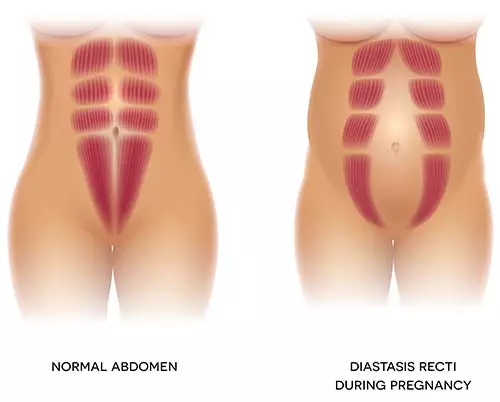
Diastasis recti is caused by the pulling apart of the rectus abdominis. Rectus abdominis is the muscle that we commonly call the “six pack.” The two parallel muscles of the diastasis recti run vertically down on each side of the abdomen and are separated by a band of connective tissue known as the linea alba.
When the baby starts growing, your body readjusts itself as the pregnancy hormones help relax the muscles. This may cause the rectus abdominis to get separated, in turn leading to diastasis recti.
The rectus abdominis also helps hold the internal organs in place. But due to diastasis recti, the internal organs, like the bowels and uterus, are only held by a band of connective tissue. This lack of connective tissue causes the organs to bulge out.

Mostly, the diastasis recti heals itself after childbirth. But in many cases, it doesn’t heal and may need exercise therapy. Diastasis recti can occur in newborn babies as well as men (due to incorrect exercise technique). Before we start with the exercises, here are the main symptoms of diastasis recti.
Key Takeaways
- Diastasis recti is a common condition in recent mothers, where a small gap develops between the two abdominal muscles.
- Pelvic tilts are a great transverse abdominis activation exercise if you want to strengthen your hip and lower back muscles and thus successfully tackle diastasis recti.
- Practice Slightly Hyperextended Bridge, which targets core muscles.
Symptoms Of Diastasis Recti
- Poor posture
- Bloating
- Low back pain
- Bulging out of internal organs in the standing position
- Disappearance of the bulge in the lying position
- More than a two-finger-width gap between the muscles in your navel area
- Constipation
Not all women will show the same symptoms after giving birth. In fact, some may not have any at all. It is important to see your doctor regularly to check how your core muscles and stomach are doing. Now that you are aware of the symptoms, let’s quickly see if you really have diastasis recti. Here’s how you can tell.
Diastasis Recti Test

- Lie down on your back with your knees flexed, and feet flat on the floor.
- Lift your head slightly and place two (or three) fingers on your belly button.
- Press your fingers lightly and see if there’s a gap.
- If there is a gap, then you have diastasis recti.
NOTE: Consult your doctor before concluding that you have diastasis recti or doing any of the following core exercises.
If you have diastasis recti (abdominal separation) and your doctor gives you the green light to proceed, you may start with the following abdominal separation exercises. In addition, you can also practice some core strengthening exercises, only with the permission of your medical expert.
11 Best Exercises For Treating Diastasis Recti
1. Pelvic Tilt
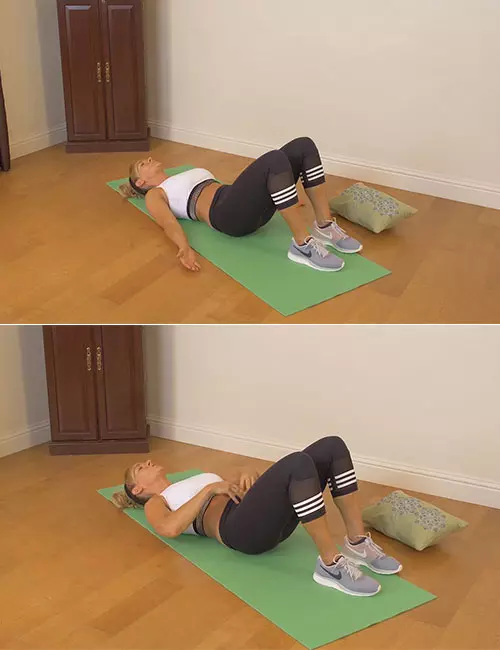
This is one of the fundamental exercises for diastasis recti, as it encourages gentle activation of the abdominal muscles without putting excessive strain on the midline or the back. It helps engage the deep core and pelvic muscles. To perform the exercise, start with smaller tilts and gradually increase the range of motion as your core strengthens. As you progress, you may also perform the exercise on an unstable surface, such as a stability ball to challenge balance.
Target – Core stabilizers and pelvic floor muscles
How To Do
- Lie down on a mat with your knees flexed and feet flat on the floor. Keep your hands by your side, palms facing the ceiling, and rotate your hip up toward your face.
- Engage your core by tilting your pelvis up so that your entire back, till your tailbone, is against the floor.
- Hold this pose for a second and then relax.
- Repeat this 10 times.
Sets And Reps
– 3 sets of 10 reps
Rest – 30 seconds between each rep
2. Heel Slide
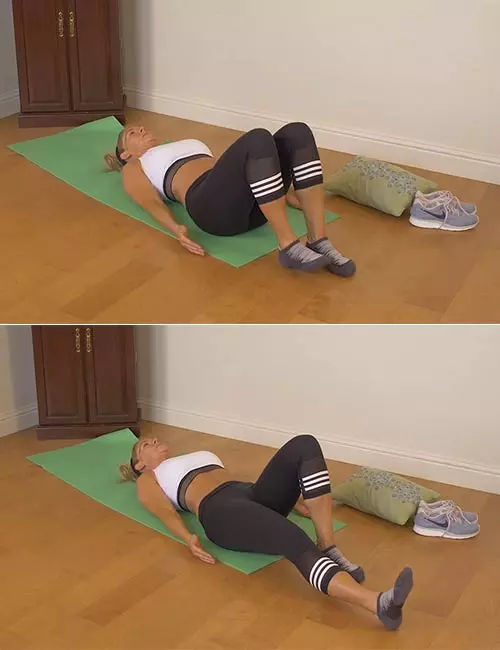
This low-impact movement is easy to perform and a great exercise for diastasis recti. It focuses on engaging the core, glute, and pelvic muscles while maintaining spinal alignment. Begin with slow, controlled movements before increasing speed. If you are a beginner, you can use socks or a slider under your heel to reduce friction. You can also consider adding light ankle weights as strength increases.
Target – Core, glutes, and pelvic muscles
How To Do
- Lie down on a mat and keep your knees flexed with the feet flat on the floor. Keep your hands by your side, palms facing the ceiling, and toes pointing up. This is the starting position.
- Slide your right heel and straighten your right leg.
- Hold the pose for a moment and then slide your heel back to the starting position.
- Repeat 10 times.
- Do the same exercise with your left leg.
Sets And Reps
– 2 sets of 10 reps
Rest – 30 seconds between each rep
3. Heel Slide Circles

This exercise takes the basic heel slide a step further by incorporating circular movements. It increases core engagement and promotes pelvic control. Start with small circles and gradually increase their size to avoid any injuries. Increase the number of repetitions as endurance improves. You can also try performing the exercise with both legs simultaneously for advanced fitness levels.
Target – Core, glutes, and pelvic muscles
How To Do
- Lie down on a mat with your knees flexed and feet flat on the floor. Keep your hands by your side, palms facing the ceiling, and your spine in a neutral position. This is the starting position.
- Slide your right heel and straighten your right leg.
- Make a “scooping” motion with your leg by lifting your heel off the floor, flexing your knee, and then placing your foot back in the starting position.
- Repeat the move 10 times before switching legs.
Sets And Reps
– 2 sets of 10 reps
Rest – 30 seconds between each rep
4. Bent Knee Raise
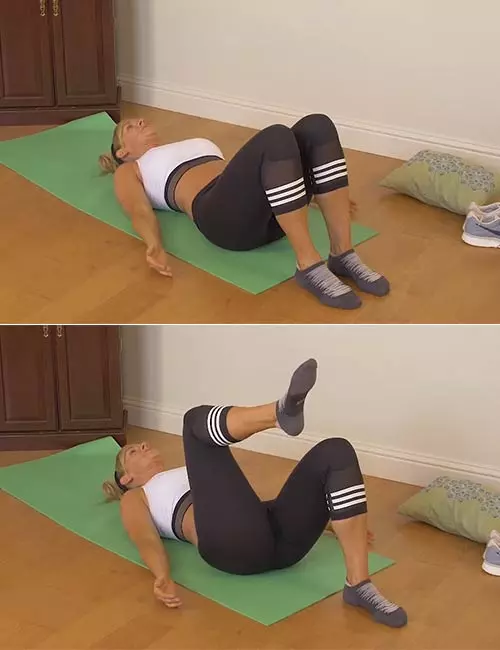
This exercise involves lifting one leg at a time with your knees bent. It encourages core and pelvic muscle engagement without placing undue stress on the back and spine. Begin with slow and controlled movements then, as you progress, slow down the lowering phase to increase core engagement. Hold the raised position for a few seconds before lowering.
Target – Core, glutes, and pelvic muscles
How To Do
- Lie down on a mat and keep your knees flexed and feet flat on the floor. Keep your hands by your side, palms facing the ceiling, and your spine in the neutral position. This is the starting position.
- Keeping your knees flexed, lift your right leg off the floor and then bring it back to the starting position.
- Do this 10 times before switching legs.
Sets And Reps
– 3 sets of 10 reps
Rest – 60 seconds between each set
5. Pelvic Pillow Squeeze
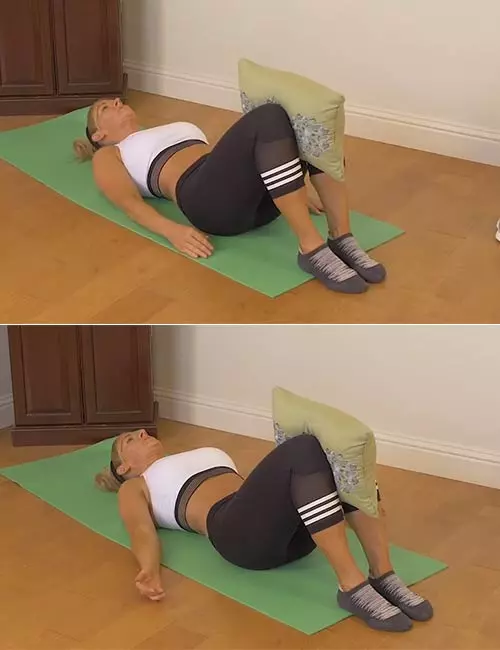
This is a simple yet effective exercise for diastasis recti. It strengthens the pelvic floor and aids deep core activation, making it particularly helpful for postpartum individuals. Using a pillow or cushion in the exercise promotes controlled muscle engagement while reducing pressure on the abdominal wall. As you progress through the exercise, consider increasing the duration of each squeeze up to 5-10 seconds. You can also perform it in a bridge position to activate additional muscle groups.
Target – Core, pelvic muscles, and abductor
How To Do
- Lie down on your back, keep your knees flexed, and feet flat on the floor with your hands by your side and palms facing up.
- Place a pillow between your legs, and keep your spine in the neutral position.
- Press your knees together and squeeze the pillow. Hold this pose for 3 seconds. Relax.
- Repeat 10 times.
Sets And Reps
– 3 sets of 10 reps
Rest – 60 seconds between each set
6. Slightly Hyperextended Bridge
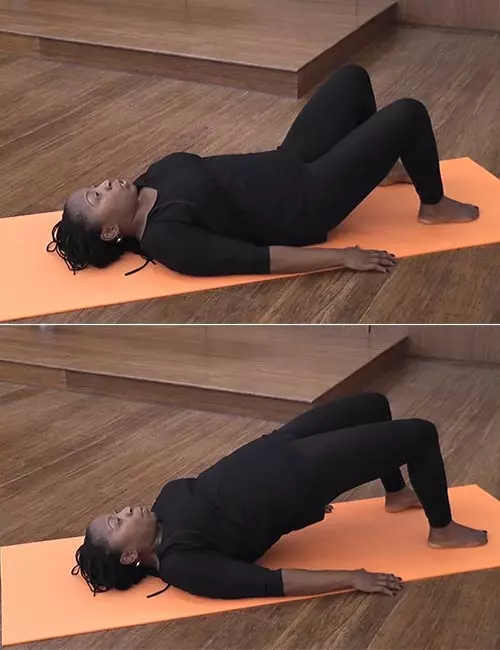
This is a modified version of the traditional bridge exercise. It allows for greater glute and core activation while maintaining spinal alignment. This movement helps improve pelvic stability, strengthens the posterior chain, and supports lower back health. It is an excellent exercise for diastasis recti recovery. If you are a beginner, start with a standard bridge before progressing to the hyperextended version. As you progress and build strength, you can add resistance by placing a weight on your pelvis.
Target – Core, glutes, quads, and hamstrings
How To Do
- Lie down on your back, flex your knees, and keep your feet and palms flat on the floor.
- Push your pelvis down so that your lower back is against the floor. This is the starting position.
- Exhale, squeeze your glutes, and lift your hips toward the ceiling. Lift your core a little higher than the regular bridge exercise.
- Hold this pose for 3 seconds and then slowly lower your back to the floor.
Sets And Reps
– 3 sets of 5 reps
Rest – 60 seconds between each rep
7. Lying Overhead Reach
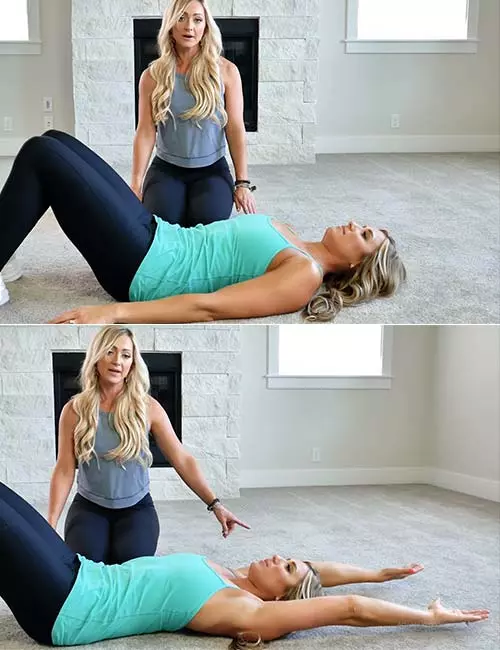
This gentle movement helps improve upper body mobility while reinforcing deep core engagement. It is beneficial for individuals with diastasis recti as it promotes mindful movement and enhances postural control. To perform this exercise safely, start with slow and controlled movements. As you progress, increase the range of motion by reaching further back. You may also slow down the movement to enhance muscle engagement.
Target – Core, glutes, quads, and hamstrings
How To Do
- Lie down on your back, flex your knees, and keep your feet and palms flat on the floor.
- Push your pelvis down so that your lower back is against the floor. This is the starting position.
- Keeping your arms extended, lift them off the floor, above your head, and bring them almost all the way to the ground.
- Pause for a second and bring your arms back down slowly to the starting position.
Sets And Reps
– 3 sets of 10 reps
Rest – 60 seconds between each set
8. Knee To Chest

This exercise for diastasis recti helps release tension in the lower back while activating the core, glutes, quads, and hamstrings. It promotes controlled muscle engagement without excessive strain. Choose a flat surface to safely perform this exercise and hold the knee-to-chest position for a few seconds before lowering. As you progress, you may also add a gentle pull with your hands to deepen the stretch.
Target – Core, glutes, quads, and hamstring
How To Do
- Lie down on your back, flex your knees, and keep your feet and palms flat on the floor.
- Push your pelvis down so that your lower back is against the floor. This is the starting position.
- Lift your right leg off the floor and bring your right knee close to your chest.
- Bring it back to the starting position slowly.
- Lift your left leg off the floor and bring your left knee close to your chest.
Sets And Reps
– 3 sets of 10 reps
Rest – 60 seconds between each set
9. Abduction With Core Activation
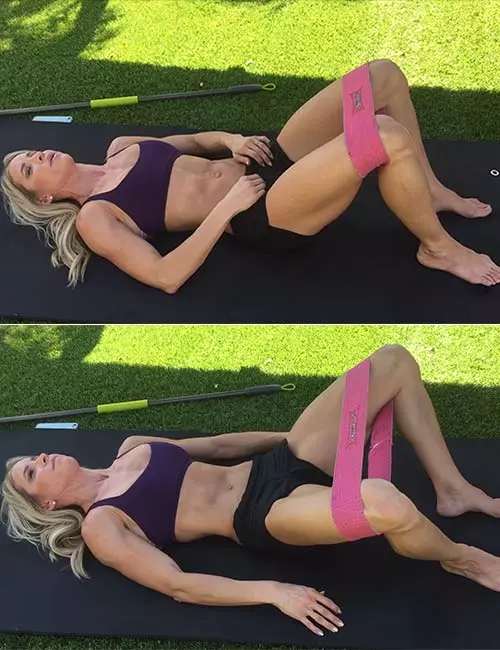
This is a resistance-based exercise for diastasis recti. It helps strengthen the outer thighs, pelvic floor, and deep core muscles. Using a resistance band encourages stability and muscle coordination and promotes gradual strength building without compromising the healing process. Start slowly to perform the exercise safely. As you progress and build strength, increase the number of reps per set.
Target – Core, abductor, pelvic floor, glutes, and quads
How To Do
- Lie down on your back, flex your knees, and keep your feet flat on the mat.
- Take a resistance band and place it just above your knees. This is the starting position.
- Exhale, engage your core, pull your knees apart, and then bring them back to the starting position. Inhale as you bring your knees back.
Sets And Reps
– 2 sets of 10 reps
Rest – 60 seconds between sets
10. Alternating Leg Circles
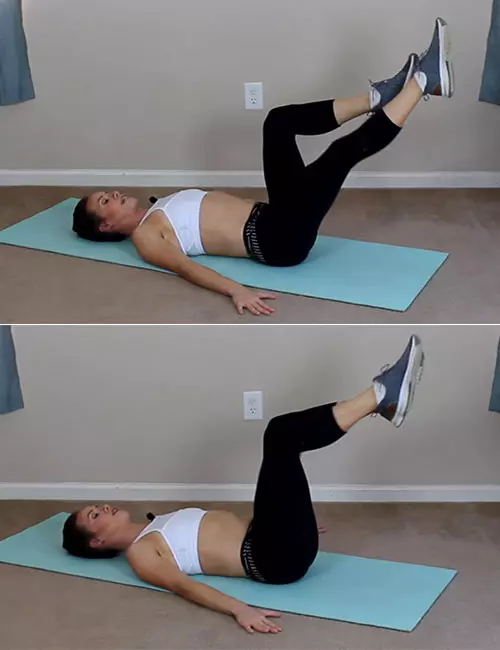
This exercise encourages gentle core engagement while improving coordination and flexibility. It is particularly beneficial for diastasis recti recovery, as it allows for progressive strengthening without excessive pressure on the midline or back. Begin with smaller circles and gradually increase the size. As you progress, increase the number of reps and slow down the movement for better control and activation.
Target – Core, glutes, quads, and hamstrings
How To Do
- Lie down on a mat, keep your legs together, palms flat on the floor, and look up at the ceiling.
- Lift both your legs and flex your knees. This is your starting position.
- Straighten your right leg and draw two small imaginary circles with it.
- Flex your right knee and bring it back to the starting position.
- Do the same with your left leg.
Sets And Reps
– 2 sets of 5 reps on each leg
Rest – 30 seconds between reps, and 60 seconds between sets
 Quick Tip
Quick Tip11. Dead Bug
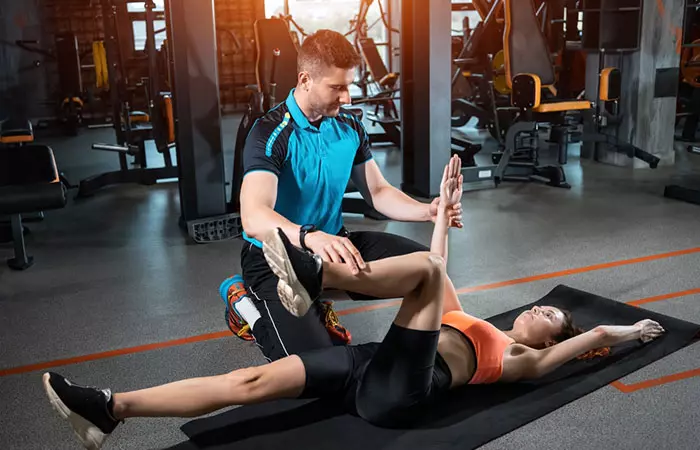
This is one of the most effective core-strengthening exercises for diastasis recti recovery. It focuses on stabilizing the core and pelvic floor muscles while improving coordination between the upper and lower body. If you are a beginner, start by moving only the arms, then progress to moving arms and legs together. As you progress, hold a light weight in each hand to increase resistance.
Target – Core and pelvic floor muscles
How To Do
- Lie on your back on a mat with your knees bent at a 90-degree angle.
- Lift your feet off the floor and arms extended straight up toward the ceiling.
- Bring your right arm and left leg down to the ground simultaneously while you keep your lower back pressed firmly against the floor.
- Extend your right arm and left leg far as you comfortably can without allowing your lower back to arch.
- Repeat with the opposite arm and leg.
Sets And Reps
– 3 sets of 10 reps on each side
Rest – No rest between reps, 30 seconds between sets
Jessica, a yoga and fitness instructor and a Youtuber, shares how she healed her diastasis recti after pregnancy with exercise. She observes the exercises that helped reduce her pregnancy belly and back pain and records the results as follow: “I don’t have any diverticulitis symptoms, I feel my core is strong and engaged, the five to six months pregnancy belly has gone away, I don’t have any back pain and leaking as well (i). ”
The exercises above will help strengthen your core and get your ab muscles back to normal again. In addition to the above-mentioned exercises, you can also try side-lying leg lift exercises, pelvic tilt exercises, and posture correction exercises for diastasis recti. Or practicing some modified exercises for diastasis recti, including yoga for diastasis recti, may help improve this condition.
Consult your healthcare provider before engaging in these exercises to ensure they are appropriate for your specific condition. Also, avoid straining your abdominal muscles and listen to your body for signs of discomfort. If you feel any pain or pressure when performing these exercises, stop immediately and let your physician know. Additionally, it’s important to also know which exercises you should avoid. The exercises below can weaken and worsen your condition.
Diastasis Recti Exercises To Avoid
- Crunches
- Plank
- Sit-ups
- Bicycle crunches
- Leg up crunches
- Russian twist
- Jackknife
- Oblique curls
- Reverse curls
- Roll-ups
- Full push-ups
Note: You can try some plank variations for diastasis recti. However, consult your fitness trainer before you do.
In other words, if you want to improve your diastasis recti, then you should avoid traditional core-strengthening exercises and focus on low-impact exercises.
Apart from doing the right physical therapy exercises and avoiding the regular core strengthening exercises, here are a few other things you can do to improve your condition.
Other Things To Do
- Practice good posture.
- Start following the right breathing exercises
- Avoid lifting heavy objects.
- Flex your knees and roll out of bed.
- Place a pillow to support your back while sitting.
- Consider wearing a supportive belly band or wrap for gentle compression.
- Eat a balanced diet and stay hydrated to promote skin elasticity and tissue recovery.
Write down what exercises you are doing and how you feel to keep track of how your condition is. Look for changes in your core strength, posture, and the gap between your belly muscles. It is also a good idea to see a physical therapist regularly to check on your progress.
In addition, abdominal bracing exercises, pilates for diastasis recti and bridge variations for diastasis recti may be considered safe and effective.
 Quick Tip
Quick TipThese extra precautions will protect you from the following complications.
Diastasis Recti Complications
- Low back pain
- Weak pelvic floor muscles
- Bad posture
- Weak trunk mobility and stability
- A hernia
Infographic: 4 Best Exercises For Diastasis Recti
Diastasis recti is a condition that usually occurs after childbirth. There are many natural and safe ways to treat this condition, and one of the most effective ones is regular exercise. Daily exercise not only shapes your abs but also reduces the gap between your rectus abdominis muscles, known as the diastasis recti. Taking care of these abdominal muscles is crucial as they hold and protect the viscera. Check out the infographic below for the 4 best exercises to improve and heal from the condition after pregnancy.
Some thing wrong with infographic shortcode. please verify shortcode syntaxPregnancy and incorrect exercise techniques cause the two vertical abdominal muscles to pull apart. The 10 exercises listed above, which are highly effective in treating this condition, act on your pelvic floor muscles, core stabilizers, glutes, abductor, quads, and hamstrings. Remember, exercises like crunches, plank, sit-ups, and bicycle crunches can aggravate this condition further, so make sure you avoid doing them. Also, make sure you avoid lifting weights and focus on your posture. Don’t be in a hurry for quick results, and have a proper plan chalked out after consulting a doctor.
Frequently Asked Questions
Is walking good for diastasis recti?
Yes, walking with the right posture can engage your core muscles and help make diastis recti better.
Can I have a flat stomach with diastasis recti?
Yes, you may have a flat belly with this condition.
Can diastasis recti be corrected years later?
Yes, your abdominal muscles can get back in place with proper and regular exercise.
Will losing weight help diastasis recti?
It may help improve the appearance. However, exercise is needed to correct the gap.
Is cycling good for diastasis recti?
Yes, cycling with the right posture can help with diastis recti.
Can diastasis recti cause belly fat?
No, it leads to an appearance of bulging fat.
Illustration: Exercises For Diastasis Recti That Strengthen Your Core

Image: Dall·E/StyleCraze Design Team
Struggling with diastasis recti? Click on the informative video below to learn simple and effective exercises that can reduce the discomfort caused by this condition and help build a stronger core.
Personal Experience: Source
StyleCraze's articles are interwoven with authentic personal narratives that provide depth and resonance to our content. Below are the sources of the personal accounts referenced in this article.
i. How I Healed My DIASTASIS RECTI (belly bulge) | Diastasis Recti Exercises + Mistakes!https://www.youtube.com/watch?v=jJ_n57etU6c
References
Articles on StyleCraze are backed by verified information from peer-reviewed and academic research papers, reputed organizations, research institutions, and medical associations to ensure accuracy and relevance. Read our editorial policy to learn more.
- Diastasis recti abdominis – a review of treatment methods
https://pubmed.ncbi.nlm.nih.gov/29512814/ - Prevalence and risk factors of diastasis recti abdominis from late pregnancy to 6 months postpartum, and relationship with lumbo-pelvic pain
https://pubmed.ncbi.nlm.nih.gov/25282439/
Read full bio of Dr. Stacy Marie Chimento
Read full bio of Ravi Teja Tadimalla
Read full bio of Payal Karnik






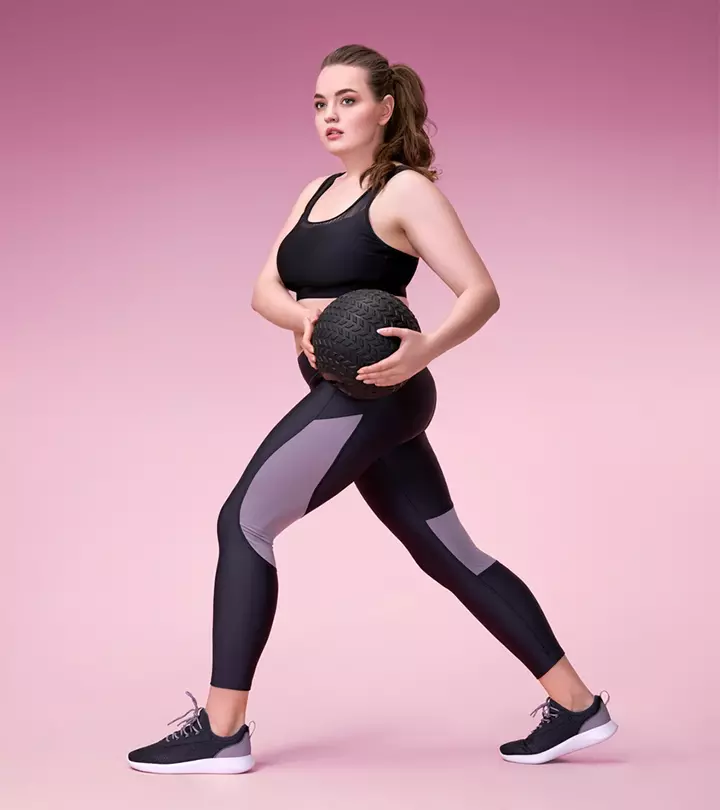

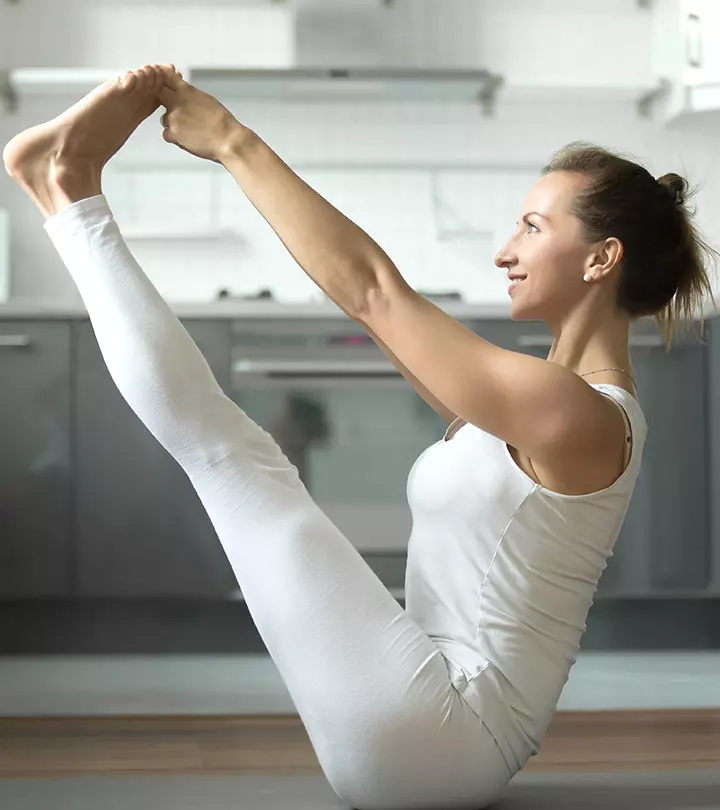





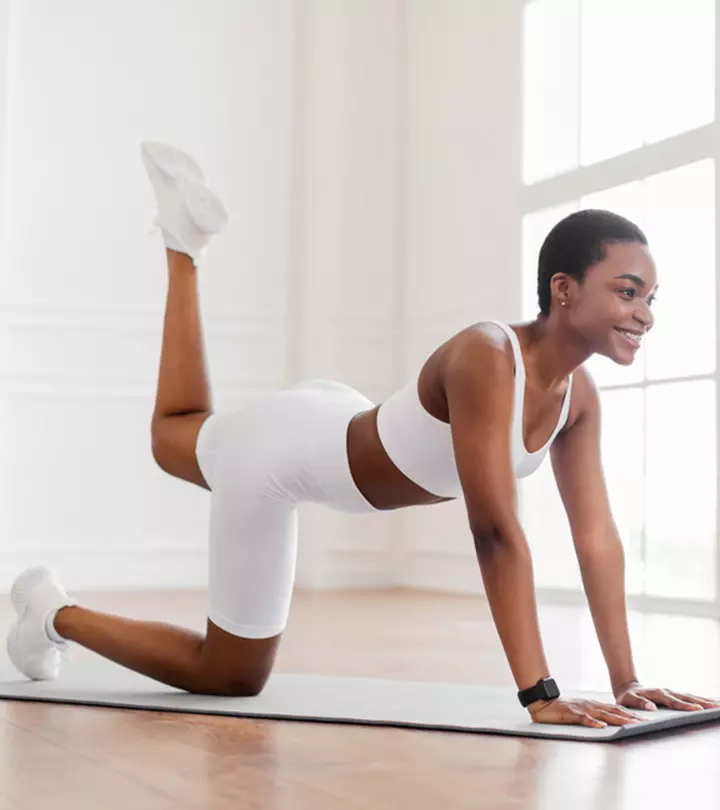

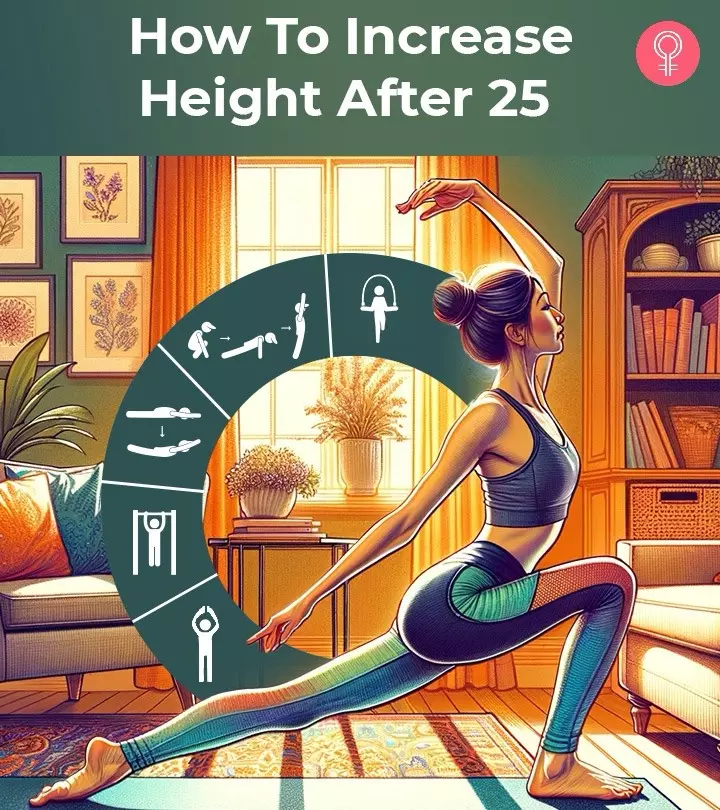
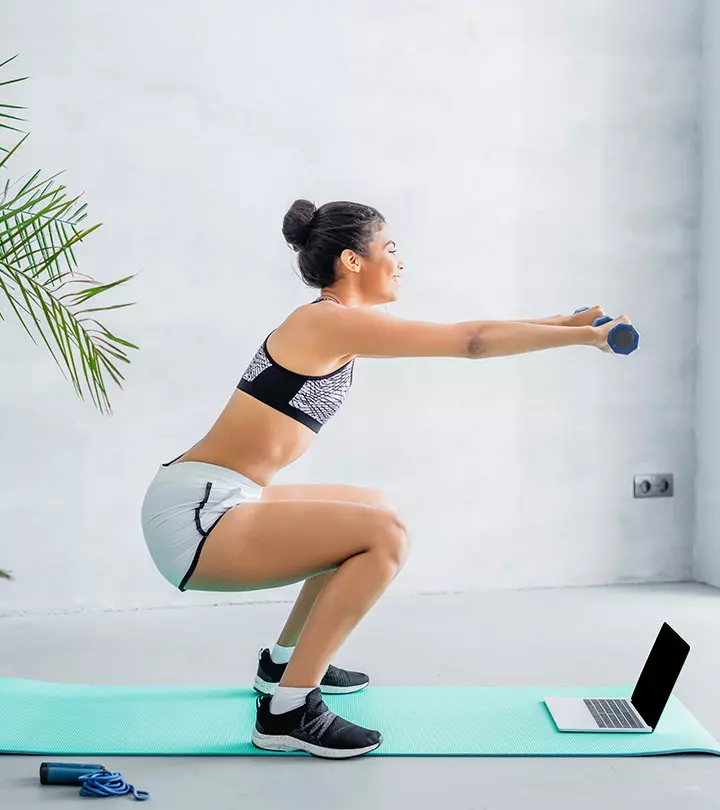





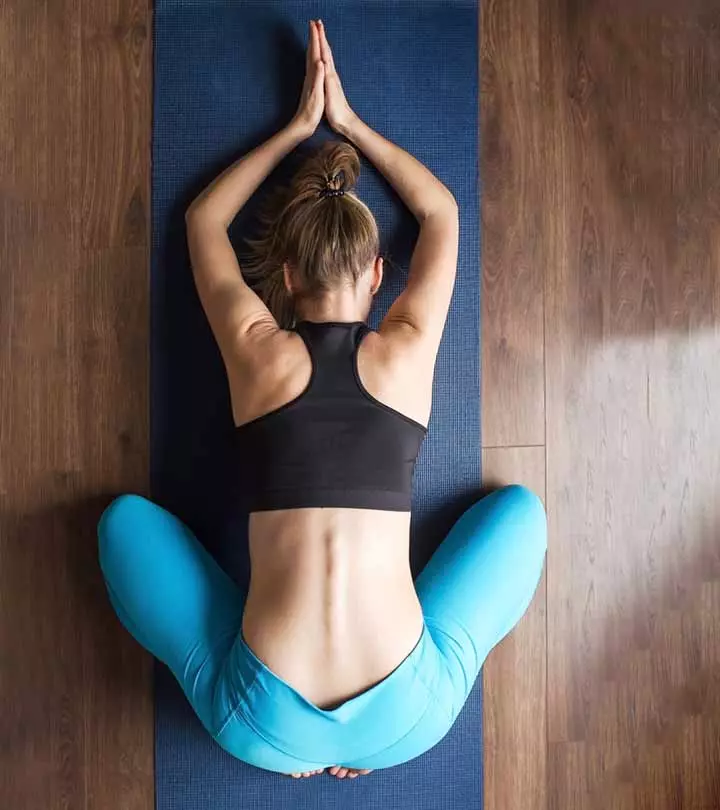



Community Experiences
Join the conversation and become a part of our empowering community! Share your stories, experiences, and insights to connect with other beauty, lifestyle, and health enthusiasts.